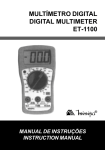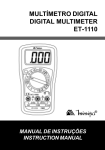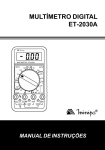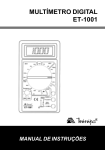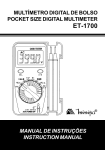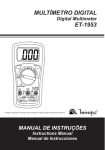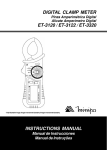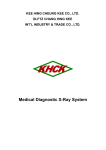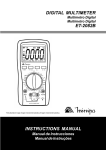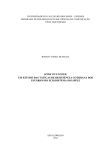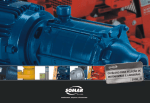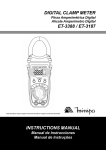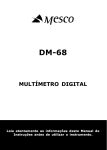Download MULTÍMETRO DIGITAL DIGITAL MULTIMETER ET-2053
Transcript
MULTÍMETRO DIGITAL DIGITAL MULTIMETER ET-2053 MANUAL DE INSTRUÇÕES INSTRUCTION MANUAL ÍNDICE 1. INTRODUÇÃO ................................................... 02 2. INFORMAÇÕES DE SEGURANÇA .................. 02 3. ESPECIFICAÇÕES ............................................ 04 3.1 Especificações Gerais ............................... 04 3.2 Especificações Elétricas ............................ 05 4. DESCRIÇÃO DO PAINEL FRONTAL .............. 09 5. OPERAÇÃO ........................................................ 10 5.1 Medidas de Tensão AC / DC ..................... 11 5.2 Medidas de Corrente AC / DC .................. 12 5.3 Medidas de Resistência ............................. 12 5.4 Medidas de Freqüência .............................. 13 5.5 Medidas de Capacitância ........................... 14 5.6 Medidas de Temperatura ............................ 14 5.7 Teste de Diodo ............................................. 15 5.8 Teste de Continuidade ................................ 15 5.9 Data Hold ..................................................... 16 6. MANUTENÇÃO ................................................... 17 6.1 Troca de Bateria .......................................... 17 6.2 Troca de Fusível ......................................... 18 7. ACESSÓRIOS .................................................... 18 8. GARANTIA ........................................................... 19 1 1. INTRODUÇÃO É um instrumento de teste portátil, compacto e operado por bateria. Possui as seguintes características de medida para aplicações principalmente domésticas e de hobistas. - Tensão DC e AC - Corrente DC e AC - Resistência - Capacitância - Freqüência - Temperatura - Teste de Diodo e Continuidade - Data Hold - Autorange 2. INFORMAÇÕES DE SEGURANÇA Este manual contém informações e advertências que devem ser seguidas para uma operação segura do instrumento e para mantê-lo em condições seguras de operação. No caso de qualquer dúvida com relação ao comprometimento da proteção proporcionada pelo instrumento, inutilize o multímetro imediatamente. A proteção pode estar comprometida se, por exemplo, o instrumento: - Apresentar danos visíveis. - Apresentar falha na execução de medidas. - For armazenado por muito tempo em condições desfavoráveis. - For submetido a vibrações de transporte severas. 2 Termos deste Manual CAUTELA Identifica condições ou práticas que podem resultar em danos ao instrumento ou nos equipamentos em teste. ADVERTÊNCIA Identifica condições ou práticas que podem resultar em ferimentos pessoais ou até mesmo a perda da vida. Termos Encontrados no Instrumento ATENÇÃO: Refira-se ao manual. PERIGO: Indica terminais onde podem existir tensões perigosas. ADVERTÊNCIA 1. Para evitar choque elétrico ou danos ao instrumento, não aplique tensões superiores a 600V DC ou AC RMS entre os terminais de entrada do instrumento. 2. Observe as precauções de segurança adequadas quando trabalhar com tensões acima de 60V DC ou 30V AC RMS. Tais tensões podem expor o usuário a choques elétricos perigosos. 3. Assegure-se de que as pontas de prova estejam em boas condições de segurança. CAUTELA Para evitar danos ao instrumento: - Desconecte as pontas de prova do circuito em teste antes de mudar de função de medida. 3 - Nunca conecte tensões superiores a 600V DC ou 600V AC RMS. - Nunca conecte tensão aos terminais de entrada quando a chave rotativa estiver selecionada para medir resistência. - Máxima tensão na entrada na função temperatura: 60V DC ou 24V RMS AC na função Temperatura. Uso do Fusível Apropriado Para evitar chamas perigosas, utilize o fusível correto, do mesmo tipo e especificação de corrente e tensão de operação, como especificado. O uso do fusível com especificação diferente ou curto-circuitar o soquete do fusível é proibido e pode ter conseqüências extremamente graves. 3. ESPECIFICAÇÕES 3.1 Especificações Gerais - Display: 3 ¾ Dígitos (4000 Contagens). Indicação de Sobre-faixa: OL. Taxa de Amostragem: 3 vezes / segundo. Auto Power Off: 15 minutos. Auto Range. Função Data Hold. Indicação de Bateria Fraca: é mostrado. Temperatura de Operação: 0°C a 40°C, RH < 75%. Temperatura de Armazenamento: -20°C a 60°C, RH < 80%. - Uso Interno. - Certificação: CE - CAT II 600V. 4 - Alimentação: Duas baterias 1.5V AAA. - Dimensões: 138(A) x 72(L) x 38(P)mm. - Peso: Aproximadamente 205g (com bateria). 3.2 Especificações Elétricas Especificações válidas para ciclo de calibração de um ano, temperatura de operação de 18°C a 28°C (64°F a 82°F) e umidade relativa < 70%. Tensão DC FAIXA RESOLUÇÃO PRECISÃO 400mV 100µV ±(0.5%+4D) 4V 1mV 40V 10mV 400V 100mV 600V 1V ±(0.8%+4D) - Impedância de Entrada: 10MΩ. - Proteção de Sobrecarga: 600V DC / 600V AC RMS. Tensão AC FAIXA RESOLUÇÃO 4V 1mV 40V 10mV 400V 100mV 600V 1V PRECISÃO 50Hz/60Hz 40 ~ 400Hz ±(0.8%+4D) ±(1.2%+5D) ±(2%+5D) - Resposta em Freqüência: 40 a 400Hz. - Impedância de Entrada: 10MΩ. - Proteção de Entrada: 600V DC / 600V AC RMS. 5 Corrente DC FAIXA RESOLUÇÃO 400µA 0.1µA 4000µA 1µA 40mA 10µA 200mA 100µA 10A 10mA PRECISÃO ±(1.2%+4D) ±(2.5%+4D) - Proteção de Sobrecarga: Fusível Ação Rápida 0.25A/ 250V para Entrada mA. Sem Fusível para Entrada 10A (10A máximo por 15s). Corrente AC F AIXA RE SO L UÇ Ã O 4 00 µA 0.1 µA 40 00 µA 1 µA 40 mA 10 µA 2 00 mA 1 00 µA 1 0A 10 mA PR EC ISÃ O ± (1 .5% + 5D ) ±( 3% + 5D ) - Resposta em Freqüência: 40 ~ 400Hz - Proteção de Sobrecarga: Fusível Ação Rápida 0.25A/ 250V para Entrada mA. Sem Fusível para Entrada 10A (10A máximo por 15s). Temperatura - Faixa: -20°C a +750°C / -4°F ~ +1400°F. - Resolução: 1°C / 1°F. - Precisão: -20°C ~ +400°C / -4°F ~ +750°F ±(1%+4D). +400°C ~ +750°C / +750°F ~ +1400°F ±(3%+10D). 6 - Faixa de Medida do Termopar: -40°C ~ 204°C - Precisão do Termopar: ±0.75% ou ±2.2°C - Máxima Tensão na Entrada na Função Temperatura: 60V DC ou 24V RMS AC. Resistência FAIXA RESOLUÇÃO 400Ω 0.1Ω 4kΩ 1Ω 40kΩ 10Ω 400kΩ 100Ω 4MΩ 1kΩ 20MΩ 10kΩ PRECISÃO ±(1.2%+4D) ±(3%+5D) - Proteção de Sobrecarga: 500V DC / 500V AC RMS. Freqüência FAIXA RESOLUÇÃO 10Hz 0.01Hz 100Hz 0.1Hz 1kHz 1Hz 10kHz 10Hz 100kHz 100Hz 1MHz 1kHz 5MHz 10kHz PRECISÃO ±(1%+4D) (10Hz ~ 1MHz) - Sensibilidade: 1V AC RMS. - Tensão Máxima de Entrada: 250V AC RMS, 50 ~ 60Hz 5V AC RMS, 10 ~ 1MHz 7 Capacitância FAIXA RESOLUÇÃO 4nF 0.001nF 40nF 0.01nF 400nF 0.1nF 4µF 0.001µF 40µF 0.01µF 100µF 0.1µF PRECISÃO ±(3%+10D) Diodo - Indicação: Queda de Tensão Direta Aproximada sobre o Diodo. - Resolução: 0.001V - Tensão de Teste: 1.5V DC (máximo). - Corrente de Teste: ±0.6mA. Continuidade - Indicação: Sonora. - Limiar: Um sinal sonoro é emitido quando a resistência medida estiver abaixo de aproximadamente 50Ω . 8 4. DESCRIÇÃO DO PAINEL FRONTAL Refira-se a Figura 1 para a localização dos controles e terminais. 1 2 3 Figura 1 9 1. Display: Apresenta o valor da leitura. 2. Chave Rotativa: Liga e desliga o instrumento e seleciona a função e a faixa de medida. 3. Terminais de Entrada: Terminais para conexão das pontas de prova. COM - Terminal comum para conexão da ponta de prova preta para todas as medidas. VAΩHzCxTemp - Terminal positivo para conexão da ponta de prova vermelha para as medidas de tensão AC e DC, corrente AC e DC até 200mA, resistência, capacitância, freqüência e temperatura e para o teste de diodo e continuidade. 10A DC - Terminal positivo para conexão da ponta de prova vermelha para a medida de corrente AC e DC entre 200mA e 10A. 5. OPERAÇÃO ADVERTÊNCIA Leia e entenda completamente este manual de instruções antes de usar o instrumento. O erro de operação ou de desacordo com as instruções e advertências do manual de instruções pode resultar em ferimentos sérios ou até fatais, além de danos materiais. Preparação e Cautela Antes das Medidas 1. Aguarde pelo menos 30 segundos após ter ligado o instrumento antes de efetuar a medida. 10 2. A chave rotativa deve ser posicionada na função de medida adequada antes de se conectar as pontas de prova ao dispositivo a ser testado. Assegurese de desconectar as pontas de prova dos pontos de teste antes de mudar a chave rotativa para uma nova função ou faixa. 3. Se o multímetro é utilizado próximo de equipamentos que gerem interferência eletromagnética, o display pode tornar-se instável ou apresentar valores incorretos. 4. Não permita que o instrumento entre em contato com água ou qualquer outro líquido. 5.1 Medidas de Tensão AC / DC ADVERTÊNCIA Não aplique mais que 600V DC ou 600V AC RMS entre os terminais de entrada VAΩHzCxTemp e COM. Exceder estes limites pode provocar choques elétricos perigosos e danos ao instrumento. Tome extremo cuidado para evitar o contato com o circuito em teste quando estiver trabalhando com alta tensão. 1. Conecte a ponta de prova preta no terminal de entrada COM e a ponta de prova vermelha no terminal de entrada VAΩHzCxTemp. 2. Posicione a chave rotativa na faixa de tensão ( )e pressione a tecla SEL para selecionar DC ( ) ou AC ( ). 11 3. Conecte as pontas de prova sobre a fonte ou carga a ser testada. A polaridade para tensão DC é apresentada automaticamente. Quando a tensão de entrada ultrapassar o limite da faixa, o display mostrará (OL). 4. Efetue a leitura do display. 5.2 Medidas de Corrente AC / DC 1. Conecte a ponta de prova preta no terminal de entrada COM e a ponta de prova vermelha no terminal de entrada VAΩHzCxTemp para medida de corrente máxima de 200mA. Para corrente entre 200mA e 10A, conecte a ponta de prova vermelha no terminal de entrada 10A. O tempo máximo permitido de medida é de 15 segundos para 10A. 2. Posicione a chave rotativa na faixa de corrente adequada (µA para medidas até 4000µA, mA para medidas até 200mA e 10A para medidas até 10A). 3. Pressione a tecla SEL para selecionar DC ( ) ou AC ( ) 4. Desligue toda a alimentação do circuito e descarregue todos os capacitores antes de abrir o circuito para conectar o multímetro em série com a carga em teste. 5. Conecte as pontas de prova e ligue a alimentação do circuito. Efetue a leitura do display, a polaridade para corrente DC é apresentada automaticamente. 5.3 Medidas de Resistência 1. Conecte a ponta de prova preta no terminal de entrada COM e a ponta de prova vermelha no terminal de entrada VAΩHzCxTemp. 12 2. Posicione a chave rotativa na faixa de resistência (Ω). ADVERTÊNCIA Para evitar possíveis ferimentos pessoais ou danos ao instrumento, assegure-se de que o dispositivo em teste esteja totalmente desenergizado. 3. Conecte as pontas de prova sobre a resistência a ser medida. E efetue a leitura do display. NOTA: Se a resistência a ser medida exceder o valor máximo da faixa, o display mostrará (OL) e selecionará uma faixa maior. Para valores de resistência de aproximadamente 1MΩ ou maiores, o instrumento pode levar alguns segundos para estabilizar a leitura. Isto é normal para leituras de resistências altas. 5.4 Medidas de Freqüência 1. Selecione a chave rotativa para a faixa de freqüência (Hz). 2. Conecte a ponta de prova preta no terminal de entrada COM e a ponta de prova vermelha no terminal de entrada VAΩHzCxTemp. 3. Conecte as pontas de prova sobre os pontos a serem medidos e efetue a leitura de freqüência diretamente do display. ADVERTÊNCIA Para evitar possíveis ferimentos pessoais ou danos ao instrumento, respeite os valores máximos de medida. 13 5.5 Medidas de Capacitância ADVERTÊNCIA Para evitar possíveis ferimentos pessoais ou danos ao instrumento, assegure-se de que o capacitor em teste esteja totalmente descarregado. 1. Selecione a chave rotativa para a faixa de capacitância ( ). 2. Conecte a ponta de prova preta no terminal de entrada COM e a ponta de prova vermelha no terminal de entrada VAΩHzCxTemp. 3. Observe a polaridade quando necessário e conecte as pontas de prova nos terminais do capacitor. 4. Efetue a leitura da capacitância diretamente do display. NOTA: Antes da conexão do capacitor o display pode apresentar leitura diferente de zero, entretanto, este valor deve ser desprezado, pois a leitura correta será sobreposta quando o capacitor for conectado. 5.6 Medidas de Temperatura 1. Posicione a chave rotativa na faixa °C ou °F. 2. Insira a ponta preta do termopar no terminal COM e a ponta vermelha no terminal VAΩHzCxTemp. 3. Encoste a extremidade do sensor de temperatura na superfície ou área do objeto cuja temperatura será medida. 4. Efetue a leitura do display. NOTA: O instrumento deve ser mantido distante de fontes de temperatura muito altas. 14 ADVERTÊNCIA Máxima Tensão na Entrada na Função Temperatura: 60V DC ou 24V RMS AC. 5.7 Teste de Diodo 1. Conecte a ponta de prova preta no terminal de entrada COM e a ponta de prova vermelha no terminal de entrada VAΩHzCxTemp. 2. Posicione a chave rotativa na faixa e pressione a tecla SEL para selecionar a função . 3. Conecte as pontas de prova nos terminais do diodo em teste. Normalmente a queda de tensão direta de um diodo de silício bom está entre 0.4V e 0.9V. Se o diodo em teste estiver defeituoso, 000 (curto-circuito) ou próximo da sobre-faixa OL (aberto) será mostrado. 4. Inverta a conexão das pontas de prova. Se o diodo em teste estiver bom, OL deve ser mostrado. Se o diodo estiver em curto (ou resistivo), 000 ou um valor próximo será mostrado. 5.8 Teste de Continuidade 1. Desligue toda a alimentação do circuito em teste. Descarregue todos os capacitores do circuito. Qualquer tensão presente durante o teste de continuidade resultará em erros de leitura e pode danificar o instrumento se a tensão exceder o limite da proteção de sobrecarga. Posicione a chave e pressione a tecla SEL para rotativa na faixa selecionar a função . 2. Conecte a ponta de prova preta no terminal de entrada COM e a ponta de prova vermelha no terminal de entrada VAΩHzCxTemp. 15 3. Conecte as pontas de prova no circuito ou dispositivo em teste. Assegure-se de que toda a alimentação do circuito esteja desligada. 4. O circuito aberto será indicado no caso da condição de sobre-faixa. 5. A buzina irá tocar se a resistência do circuito for menor que aproximadamente 50Ω. Após finalizar todos os testes, desconecte as pontas de prova do circuito e do instrumento. 5.9 Data Hold A leitura do display será congelada quando a tecla HOLD for pressionada. Se a tecla for pressionada novamente, a leitura voltará a ser atualizada. 16 6. MANUTENÇÃO ADVERTÊNCIA Para evitar choque elétrico, remova as pontas de prova do circuito antes de abrir o instrumento. 1. Reparos e serviços não cobertos por este manual de instruções devem ser executados apenas por pessoas qualificadas. 2. Periodicamente limpe a parte externa do instrumento com pano macio umedecido em água ou detergente neutro. Não utilize produtos abrasivos ou solventes. 6.1 Troca de Bateria Utilize o seguinte procedimento para trocar a bateria. 1. Desconecte as pontas de prova do circuito em teste e desligue o instrumento. 2. Desconecte as pontas de prova do instrumento. 3. Retire o holster e coloque o multímetro com o painel frontal para baixo em uma superfície que não danifique o painel. 4. Remova os parafusos localizados no painel traseiro. 5. Cuidadosamente levante o gabinete traseiro, separando-o do gabinete frontal. 6. Cuidadosamente retire as baterias, substituindo pelas novas. 7. Encaixe o gabinete traseiro no frontal. 8. Recoloque os parafusos. 17 6.2 Troca de Fusível Refira-se ao seguinte procedimento para examinar ou trocar o fusível do multímetro. 1. Siga os passos 1 até 5 do item Troca de Bateria. 2. Remova o fusível defeituoso. 3. Instale o fusível novo de mesmo tamanho e especificação. 4. Encaixe o gabinete traseiro no frontal. 5. Recoloque os parafusos. 7. ACESSÓRIOS Após receber o seu instrumento, verifique a existência dos seguintes itens: 1. 2. 3. 4. 5. 6. Multímetro Digital Par de Pontas de Prova Manual de Instruções Baterias (Instaladas) Holster Termopar Tipo K 18 8. GARANTIA O instrumento foi cuidadosamente ajustado e inspecionado. Se apresentar problemas durante o uso normal, será reparado de acordo com os termos da garantia. GARANTIA SÉRIE Nº MODELO ET-2053 1- Este certificado é válido por 6 (seis) meses a partir da data da aquisição. 2- Será reparado gratuitamente nos seguintes casos: A) Defeitos de fabricação ou danos que se verificar, por uso correto do aparelho no prazo acima estipulado. B) Os serviços de reparação serão efetuados somente no departamento de assistência técnica por nós autorizado. C) Aquisição for feita em um posto de venda credenciado da Minipa. 3- A garantia perde a validade nos seguintes casos: A) Mau uso, alterado, negligenciado ou danificado por acidente ou condições anormais de operação ou manuseio. B) O aparelho foi violado por técnico não autorizado. 4- Esta garantia não abrange fusíveis, pilhas, baterias e acessórios tais como pontas de prova, bolsa para transporte, termopar, etc. 5- Caso o instrumento contenha software, a Minipa garante que o software funcionará realmente de acordo com suas especificações funcionais por 90 dias. A Minipa não garante que o software não contenha algum erro, ou de que venha a funcionar sem interrupção. 6- A Minipa não assume despesas de frete e riscos de transporte. 7- A garantia só será válida mediante o cadastramento deste certificado devidamente preenchido e sem rasuras. Nome: Endereço: Estado: Nota Fiscal N°: N° Série: Nome do Revendedor: Cidade: Fone: Data: 19 Cadastramento do Certificado de Garantia O cadastramento pode ser feito através de um dos meios a seguir: - Correio: Envie uma cópia do certificado de garantia devidamente preenchido pelo correio para o endereço. Minipa Indústria e Comércio Ltda. At: Serviço de Atendimento ao Cliente Alameda dos Tupinás, 33 - Planalto Paulista CEP: 04069-000 - São Paulo - SP - Fax: Envie uma cópia do certificado de garantia devidamente preenchido através do fax 0xx11-577-4766. - e-mail: Envie os dados de cadastramento do certificado de garantia através do endereço [email protected]. - Site: Cadastre o certificado de garantia através do endereço http://www.minipa.com.br/sac. IMPORTANTE Os termos da garantia só serão válidos para produtos cujos certificados forem devidamente cadastrados. Caso contrário será exigido uma cópia da nota fiscal de compra do produto. Manual sujeito a alterações sem aviso prévio. Revisão: 00 Data Emissão: 22/03/2004 20 21 TABLE OF CONTENTS 1. INTRODUCTION ............................................... 23 2. SAFETY INFORMATION .................................... 23 3. SPECIFICATION ................................................ 25 3.1 General Specification ................................. 25 3.2 Electrical Specification ............................... 26 4. FRONT PANEL DESCRIPTION ....................... 30 5. OPERATION ....................................................... 31 5.1 AC / DC Voltage Measurement ................. 32 5.2 AC / DC Current Measurement ................. 33 5.3 Resistance Measurement .......................... 33 5.4 Frequency Measurement ........................... 34 5.5 Capacitance Measurement ........................ 35 5.6 Temperature Measurement ......................... 35 5.7 Diode Test .................................................... 36 5.8 Continuity Test ............................................ 36 5.9 Data Hold ..................................................... 37 6. MAINTENANCE .................................................. 38 6.1 Battery Replacement ................................. 38 6.2 Fuse Replacement ................................... 39 7. ACCESSORIES .................................................. 39 8. WARRANTY ........................................................ 40 22 1. INTRODUCTION It is a portable test instrument, compact and operated by battery. It has the following measurement features for domestic and hobby applications. - DC and AC Voltage - DC and AC Current - Resistance - Capacitance - Frequency - Temperature - Diode and Continuity Test - Data Hold - Autorange 2. SAFETY INFORMATION This manual contains information and warnings that must be followed for operating the meter safely and maintaining the meter in a safe operating condition. In the case of any doubt regarding the integrity of the instrument, make the multimeter unusable immediately. The protection provided by the meter may be impaired if, for example: - It shows visible damages. - It fails in the execution of measurements. - It was stored for a long time in unfavorable conditions. - It was be submitted the severe vibrations in transport. 23 Terms in this Manual CAUTION It identifies practices or conditions that could result in damage to the instrument or the equipment in test. WARNING It identifies practices or conditions that could result in personal injury or loss of life. Terms in the Instrument ATENTION: Refer to the manual. DANGER: It indicates terminals dangerous voltages can be present. where WARNING 1. To avoid electric shock or damages to the instrument, do not apply voltages above 600V DC or AC RMS between input terminals of the instrument. 2. Observe the proper safety precautions when working with voltages above 60V DC or 30V AC RMS. Such voltages can expose the user to dangerous electric shocks. 3. Make sure that the test leads are in good conditions of security. CAUTION To avoid damages to the instrument: - Remove the test leads from test circuit before changing the measurement function. 24 - Never connect voltages above 600V DC or 600V AC RMS. - Never connect voltage to the input terminals when the rotary switch is selected to measure resistance. - Maximum input voltage in the temperature function: 60V DC or 24V RMS AC. Use of the Proper Fuse To avoid dangerous fires, use the correct fuse, of the same type and specification of operation current and voltage, as specified. The use of the fuse with different specification or short-circuit the fuse socket is prohibit and can cause extremely serious injury. 3. SPECIFICATION 3.1 General Specification - Display: 3 ¾ Digits (4000 Counts). Overrange Indication: OL. Sample Rate: 3 times / second. Auto Power Off: 15 minutes. Auto Range. Data Hold Function. Low Battery Indication: Display shows . Operation Environment: 0°C to 40°C, RH < 75%. Storage Environment: -20°C to 60°C, RH < 80%. Internal Use. Certification: CE Mark - CAT II 600V. Power: Two 1.5V AAA battery. Dimensions: 138(H) x 72(W) x 38(D)mm. Weight: Approx. 205g (including battery). 25 3.2 Electrical Specification Accuracy specified to one year calibration period, operation temperature of 18°C to 28°C (64°F to 82°F) and relative humidity < 70%. DC Voltage RANGE RESOLUTION ACCURACY 400mV 100µV ±(0.5%+4D) 4V 1mV 40V 10mV 400V 100mV 600V 1V ±(0.8%+4D) - Input Impedance: 10MΩ. - Overload Protection: 600V DC / 600V AC RMS. AC Voltage RANGE RESOLUTION 4V 1mV ACCURACY 50Hz/60Hz 40 ~ 400Hz ±(0.8%+4D) 40V 10mV 400V 100mV 600V 1V ±(1.2%+5D) ±(2%+5D) - Frequency Response: 40 to 400Hz. - Input Impedance: 10MΩ. - Overload Protection: 600V DC / 600V AC RMS. 26 DC Current RANGE RESOLUTION 400µA 0.1µA 4000µA 1µA 40mA 10µA 200mA 100µA 10A 10mA ACCURACY ±(1.2%+4D) ±(2.5%+4D) - Overload Protection: Fast Action Fuse 0.25A/250V to mA input. Without fuse to 10A input (10A maximum for 15s). AC Current RA NGE RE SO L UT ION 4 00 µA 0.1 µA 40 00 µA 1 µA 40 mA 10 µA 2 00 mA 1 00µA 1 0A 10 mA A C C UR AC Y ± (1 .5% + 5D ) ±( 3% + 5D ) - Frequency response: 40 to 400Hz - Overload Protection: Fast Action Fuse 0.25A/250V to mA input. Without fuse to 10A input (10A maximum for 15s). Temperature - Range: -20°C ~ +750°C / -4°F ~ +1400°F. - Resolution: 1°C / 1°F. - Accuracy: -20°C ~ +400°C / -4°F ~ +750°F ±(1%+4D). +400°C ~ +750°C / +750°F ~ +1400°F ±(3%+10D). 27 - Thermocouple measuring range: -40°C ~ +204°C - Thermocouple Accuracy: ±0.75% or ±2.2°C Resistance RANGE RESOLUTION 400Ω 0.1Ω 4kΩ 1Ω 40kΩ 10Ω 400kΩ 100Ω 4MΩ 1kΩ 20MΩ 10kΩ ACCURACY ±(1.2%+4D) ±(3%+5D) - Overload Protection: 500V DC / 500V AC RMS. Frequency RANGE RESOLUTION 10Hz 0.01Hz 100Hz 0.1Hz 1kHz 1Hz 10kHz 10Hz 100kHz 100Hz 1MHz 1kHz 5MHz 10kHz ACCURACY ±(1%+4D) (10Hz ~ 1MHz) - Sensitivity: 1V AC RMS. - Maximum Input Voltage: 250V AC RMS, 50 ~ 60Hz 5V AC RMS, 10 ~ 1MHz 28 Capacitance RANGE RESOLUTION 4nF 0.001nF 40nF 0.01nF 400nF 0.1nF 4µF 0.001µF 40µF 0.01µF 100µF 0.1µF ACCURACY ±(3%+10D) Diode - Indication: Approximate Diode Forward Voltage. - Resolution: 0.001V DC. - Test Voltage: 1.5V DC (maximum). - Test Current: ±0.6mA. Continuity - Indication: Buzzer. - Threshold: A sound signal is emitted, when the measured resistance is under approx 50Ω. 29 4. FRONT PANEL DESCRIPTION Refer to Figure 1 to identify controls and terminals. 1 2 3 Figure 1 30 1. Display: Shows the reading value. 2. Rotary Switch: Turns ON and OFF the instrument and select the function and the measurement range. 3. Input Terminals: Terminals to connect the test leads. COM - Common terminal, to connect the black test lead, used in all functions. VAΩHzCxTemp - Positive terminal, to connect the red test lead, used in AC and DC voltage, DC and AC current until 200mA, resistance, capacitance, frequency and temperature measurement and diode and continuity test. 10A - Positive terminal, to connect the red test lead, used to measure AC and DC current between 200mA and 10A. 5. OPERATION WARNING Read and understand completely this instruction manual before using the instrument. Error in operation or in discordance with the warnings and instructions of this manual, can result in material damages and serious or deadly injuries. Preparation and Caution Before Measurement 1. Wait at least 30 seconds after power on the instrument before making measurements. 31 2. The rotary switch must be positioned in the proper measurement function before connecting the test leads to the device to be tested. Make sure to disconnect the test leads from test points before changing the rotary switch to a new function or range. 3. If the multimeter is used next to equipment that generates electromagnetic interference, the display can become unstable or present incorrect values. 4. Do not allow that the instrument enters in contact with water or any another liquid. 5.1 AC / DC Voltage Measurement WARNING Do not apply more than 600V DC or AC RMS between the VAΩHzCxTemp and COM input terminals. Exceed these limits can result in dangerous electric shock and damage to the instrument. Take care to avoid contact with the circuit under test, when working with high voltage. 1. Connect the red test lead to the VAΩHzCxTemp input terminal and the black test lead to the COM input terminal. 2. Set the rotary switch to V position, and press the ) or DC ( ). SEL button to select AC ( 3. Connect the test leads to the circuit under test. The polarity to DC voltage is automatically displayed. When the input voltage exceed the range limit, the display will show (OL). 32 4. Read the measurement in the display. 5.2 AC / DC Current Measurement 1. Connect the red test lead to the VAΩHzCxTemp input terminal and the black test lead to the COM input terminal to measure current up to 200mA. To measure current between 200mA and 10A, connect the red test lead to the 10A input terminal. The maximum measurement time for 10A is 15 seconds. 2. Set the rotary switch to desired current range position (µA for measurements until 4000µA, mA for measurements until 200mA and 10A , for measurements until 10A). ) or DC ( ). 3. Press the SEL button to select ( 4. Turn off all power from the circuit under test, and discharge all capacitors before opening the circuit to connect the multimeter in series with the circuit. 5. Connect the test leads and turn on the power. Make the display reading. The polarity to DC current is automatically displayed. 5.3 Resistance Measurement 1. Connect the red test lead to the VAΩHzCxTemp input terminal and the black test lead to the COM input terminal. 2. Set the rotary switch to resistance (Ω) range position. 33 WARNING To avoid possible damage to the meter or to the equipment under test, disconnect the circuit power and discharge all high-voltage capacitors before measuring resistance. 3. Connect the test leads to the circuit under test and make the resistance reading in the display. NOTE: If the measured resistance exceed the maximum value for the range, the display will show (OL) and will select the next range. To measure resistance around 1MΩ or bigger, the instrument can take some seconds to stabilize the reading. It is normal to high resistance readings. 5.4 Frequency Measurement 1. Set the rotary switch to frequency position (Hz). 2. Connect the red test lead to the VAΩHzCxTemp input terminal and the black test lead to the COM input terminal. 3. Connect the test leads to the points to be measured and make the frequency reading in the display. WARNING To avoid possible damage to the meter or to the equipment under test, never exceed the measurement limit. 34 5.5 Capacitance Measurement WARNING To avoid possible damage to the meter or to the equipment under test, disconnect the circuit power and make sure all capacitors are discharged. 1. Set the rotary switch to capacitance position ( ). 2. Connect the red test lead to the VAΩHzCxTemp input terminal and the black test lead to the COM input terminal. 3. Verify the polarity when necessary and connect the test leads to the capacitor terminals. 4. Read the capacitance measurement in the display. NOTE: Before connect the capacitor, the display may show some reading different from zero, however, this reading must be discarded, because the correct reading will superpose the wrong reading when the capacitor is connected. 5.6 Temperature Measurement 1. Set the rotary switch to °C or °F position. 2. Insert the red test lead of K type thermocouple in VAHzΩCxTemp input terminal and the black test lead in COM terminal. 3. Touch the end of temperature sensor to the area or surface of the object to be measured. 4. Make the display reading. NOTE: The meter must be keep away from source of very high temperature. 35 WARNING Maximum input voltage in the themperature function: 60V DC or 24V RMS AC. 5.7 Diode Test 1. Connect the red test lead to the VAHzΩCxTemp input terminal and the black test lead to the COM input terminal. position and press the 2. Set the rotary switch to SEL button to select the function. 3. Connect the test leads to the diode. Normally, the forward voltage of a silicon diode is between 0.4V and 0.9V. If the diode is damaged, the display will show 000 (short-circuit condition) or OL (open condition). 4. Invert the connection of test leads. If the diode is good, OL must be displayed. If it is damaged, (shortcircuit or resistive), 000 or a near value will be displayed. 5.8 Continuity Test 1. Turn off all power of the circuit under test. Discharge all capacitors of circuit. Any voltage present during the continuity test will result in reading error and can damage the instrument if the voltage exceed overload protection limit. Set the rotary switch to range position and press the SEL button to the select the function. 2. Connect the red test lead to the VAHzΩCxTemp input terminal and the black test lead to the COM input terminal. 36 3. Connect the test leads to the circuit or device under test. Make sure that the power of circuit or device is turned off. 4. The open circuit will be indicated as overrange condition. 5. The buzzer will sound if the resistance of the circuit is less than approximately 50Ω. After complete all tests, disconnect the test leads from circuit and instrument. 5.9 Data Hold The reading will be hold when the HOLD key is pressed. If the key is pressed once again, it will release the hold and allow a further measurement. 37 6. MAINTENANCE WARNING To avoid electric shock, remove the test leads from the circuit before opening the multimeter. 1. Repairs and services not covered by this instruction manual must be done only by qualified technician. 2. Periodically wipe the housing with a damp soft cloth and mild detergent. Do not use abrasives or solvents. 6.1 Battery Replacement To replace the battery, follow the procedure listed below. 1. Disconnect the test leads from the circuit under test and turn off the meter. 2. Disconnect the test leads from the meter. 3. Place the meter with front panel over a soft surface. 4. Remove the screws located in the rear case. 5. Carefully separate the front case from the rear case. 6. Carefully remove the old batteries replacing for a new one. 7. Replace front case in the rear case. 8. Refasten the screws. 38 6.2 Fuse Replacement Refer to the following procedure to analyze or replace the fuse. 1. Repeat the step 1 to 5 of item Battery Replacement. 2. Remove the damaged fuse. 3. Install the new fuse, with the same size and specification. 4. Replace the front case in the rear case. 5. Refasten the screws. 7. ACCESSORIES After receiving your instrument, please check if the listed accessories are included in the giftbox: 1. 2. 3. 4. 5. 6. Digital Multimeter Test Leads (one pair) Instruction Manual Batteries (installed) Holster K Type Thermocouple 39 8. WARRANTY This instrument was carefully calibrated and inspected. If any failure occurs under normal use, this product will be repaired according to warranty conditions and limitations. WARRANTY SERIAL Nº 12- 3- 45- 67- MODEL ET-2053 The warranty period is 6 (six) months and begins on the date of purchase. It will be repaired free of charge in the following cases: A)Manufacturing defects or damages occurred under normal use of instrument within the warranty period. B)The services to correct the failure will be done only in authorized service center or personal will be allowed to fix this product. C)If product is purchased through a Minipa’s authorized dealer. Warranty will be void in case: A)It has been misused, altered, neglected or damaged by accident or abnormal conditions of operation or handling. B)The instrument shows violations by a non authorized repair center. This warranty does not apply to fuses, dry cells, batteries and accessories as test leads, carrying case, thermo couple, etc. For instrument with software, Minipa assumes responsibility that the software will operate in accordance with its functional specifications for 90 days. Minipa will not guarantee that the software will be error free or operate without interruption. Minipa assumes no risk for damage in transit or transportation costs. Warranty will be valid only after the registration of this certificate. Name: Address: State: Sales Voucher N°: Serial N°: Sales Agent Name: City: Phone: Date: 40 Warranty Certificate Registration Procedures The registration can be made by the following ways: - Mail: Send a copy of warranty certificate correctly filled to the following address. Minipa Indústria e Comércio Ltda. Att: Serviço de Atendimento ao Cliente Alameda dos Tupinás, 33 - Planalto Paulista CEP: 04069-000 - São Paulo - SP - Fax: Send a copy of warranty certificate correctly filled by fax number 0xx11-577-4766. - e-mail: Scanning this form and attach to your email. Please send to [email protected]. - Site: Register the warranty certificate by http:// www.minipa.com.br/sac. IMPORTANT The warranty conditions and limitations will be valid only to the certificates correctly registered. In case the purchaser did not register, a sales receipt showing the date of purchase will be required. Manual specifications subject to change without notice. Revision: 00 Date of Issue: 22/03/2004 41 Minipa Eletronics (Shangai) Co. Ltd. Add: 5th, 111 Meisheng Rd. Waigaoqiao Free Trade Zone, Shangai 200137, P.R. China Tel: 86 21 5866 6003 - Fax: 86 21 5866 2054 E-mail: [email protected] Site: www.minipa.net Minipa Indústria e Comércio Ltda. Al. dos Tupinás, 33 - Planalto Paulista - São Paulo - CEP: 04069-000 CGC: 43.743.749/0001-31 Site: http://www.minipa.com.br











































